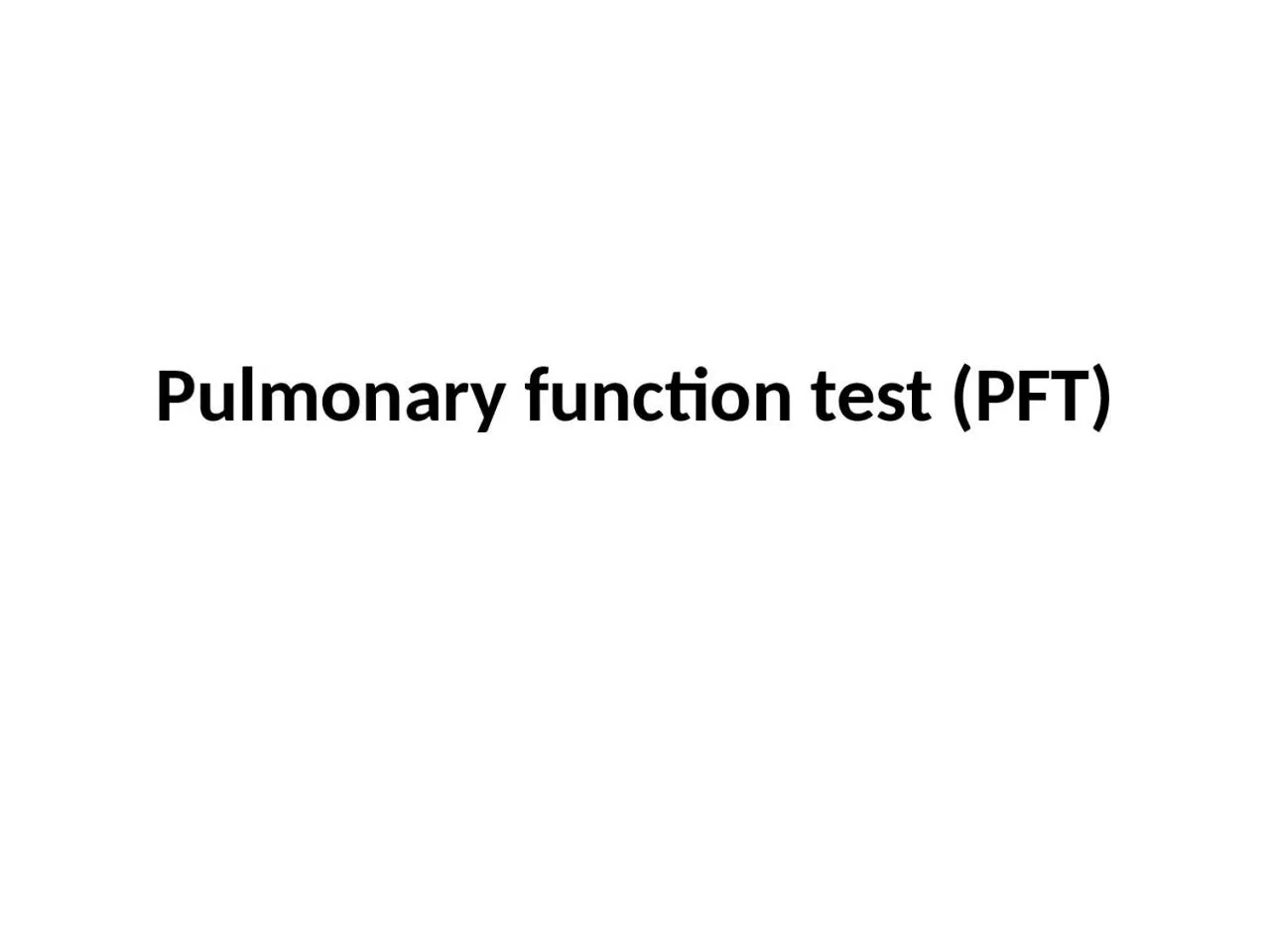

PFTs are tests for physiological assessment of pulmonary gas exchange through processes of ventilation diffusion and lung perfusion ID: 933261
Download Presentation The PPT/PDF document "Pulmonary function test (PFT)" is the property of its rightful owner. Permission is granted to download and print the materials on this web site for personal, non-commercial use only, and to display it on your personal computer provided you do not modify the materials and that you retain all copyright notices contained in the materials. By downloading content from our website, you accept the terms of this agreement.
Slide1
Pulmonary function test (PFT)
Slide2PFTs
are tests for physiological assessment of pulmonary gas exchange through processes of ventilation, diffusion, and lung perfusion.
1-Ventilation
tests through measuring lung volume (VC), airways patency (FEV1), and alveolar
ventilation.
2-Diffusion test through measuring lung efficacy for gas
exchange by quantifying respiratory and blood gases.
3-Perfusion
test through measuring pulmonary blood flow.
Slide3Benefits of PFTs:
1. Diagnose causes and severity of dyspnea (breathlessness). 2. Follow up disease progression and effectiveness
of
treatment
.
3
. Assess respiratory status before and during
anesthesia
and surgery
.
4
. Assess physical fitness and effects of training.
5
. Determine the incidence of respiratory dysfunction
.
6. Medico-legal information in occupational hazard.
Slide4Types of Pulmonary Function Tests (PFTs)
I. Clinical (bedside) tests: 1. Chest expansion measured with a tape placed around the chest just below the nipples. Normally chest expands by 5–10 cm after deep inspiration preceded by forceful expiration.
2. Breath holding time: maximum time one can hold his breathing after inhalation.
Slide53. Respiratory endurance test (40 mmHg test): disconnect the rubber tube from the mercury reservoir to the sphygmomanometer cuff. Ask the subject to take a deep breath, pinch his nostrils, and exhale into the tube to raise the mercury to 40 mm Hg and to hold it there for as long as possible.
Normal duration > 40 – 70 seconds.
Slide64
. Expiratory blast test: ask the subject to take deep breath to raise the mercury column as high level as possible. Normally one can raise the mercury > 55–100 mm during single forceful exhalation. 5. Snider’s test: hold burning match stick 12 inches in front of subject’s face and ask him to blow it out with single forceful expiration.
Slide7II. Tests of ventilation:
1. VC and FEV1. 2. Peak expiratory flow rate (PEFR). 3. Minute ventilation (MV). 4. Functional residual capacity (FRC) measured by nitrogen washout Method. 5. Ventilation Scan.
Slide8III. Tests of gas diffusion:
A- Arterial blood gases and pH.B-Respiratory gases. IV. Tests for lung perfusion: Lung scan and catheterization.
V. Special Techniques
1. Plain chest X-ray.
2. Computerized tomography (CT scan). 3. Magnetic resonance imaging (MRI).
4.
Bronchoscopy
.
5. Computerized
spirometer
.
Slide9Peak expiratory flow rate (PEFR)
It measures maximum expiration speed to monitor airflow obstruction in large airways. It is used to follow up asthmatic response to therapy and control of the disease.
Slide10Slide11Spirometry
It measures airflow and functional lung volumes through assessing how much one inhale and exhale and how quick exhalation occurs. Ask the subject to blow as fast and as long as possible until no more breath can be exhaled into mouthpiece attached to spirometer to record the rate and volume of airflow. Values obtained:
1. FEV
1
: forced expiratory volume in the first second.
2. FVC (forced vital capacity): the total lung volume from maximum inspiration to maximum expiration.
Results are plotted in graph called
vitalograph
or
spirogram
.
Slide12Slide13Tidal volume (VT):
breathing involves inspiration and expiration = 500 mLInspiratory reserve volume (IRV): Maximal inspiration followed by maximal expiration = 3000 mL
Expiratory reserve volume (ERV):
volume exhaled with maximal expiration = 1200
mL
Residual volume (RV):
volume remains in the lungs after a maximal forced expiration = 1200
mL
Lung volumes and capacities can be made by
spirometry
except residual volume which can’t be measured by
spirometry
.
Slide14